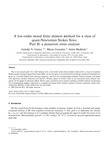A low-order mixed finite element method for a class of quasi-Newtonian Stokes flows. Part II: a posteriori error analysis

Use this link to cite
http://hdl.handle.net/2183/15597
Except where otherwise noted, this item's license is described as Reconocimiento-NoComercial-SinObraDerivada 4.0 Internacional
Collections
- Investigación (FIC) [1728]
Metadata
Show full item recordTitle
A low-order mixed finite element method for a class of quasi-Newtonian Stokes flows. Part II: a posteriori error analysisDate
2004-03Citation
G. N. Gatica, M. González, S. Meddahi, A low-order mixed finite element method for a class of quasi-Newtonian Stokes flows. Part II: a posteriori error analysis, Computer Methods in Applied Mechanics and Engineering. 193(9-11) (2004) 893-911.
Abstract
[Abstract] This is the second part of a work dealing with a low-order mixed finite element method for a class of nonlinear Stokes models arising in quasi-Newtonian fluids. In the first part we showed that the resulting variational formulation is given by a twofold saddle point operator equation, and that the corresponding Galerkin scheme becomes well posed with piecewise constant functions and Raviart–Thomas spaces of lowest order as the associated finite element subspaces. In this paper we develop a Bank–Weiser type a posteriori error analysis yielding a reliable estimate and propose the corresponding adaptive algorithm to compute the mixed finite element solutions. Several numerical results illustrating the efficiency of the method are also provided.
Keywords
Mixed finite element method
Mixed finite element method
Twofold saddle point formulation
A posteriori error analysis
Mixed finite element method
Twofold saddle point formulation
A posteriori error analysis
Editor version
Rights
Reconocimiento-NoComercial-SinObraDerivada 4.0 Internacional
ISSN
0045-7825






